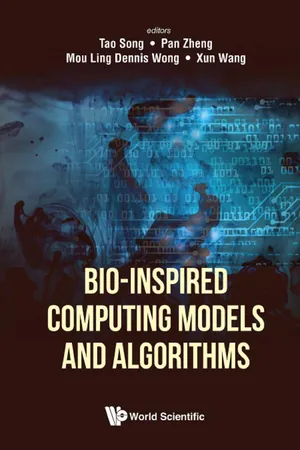
Bio-Inspired Computing Models and Algorithms
Tao Song, Pan Zheng;Mou Ling Dennis Wong;Xun Wang
- 300 pages
- English
- ePUB (adapté aux mobiles)
- Disponible sur iOS et Android
Bio-Inspired Computing Models and Algorithms
Tao Song, Pan Zheng;Mou Ling Dennis Wong;Xun Wang
À propos de ce livre
Bio-inspired computing (BIC) focuses on the designs and developments of computer algorithms and models based on biological mechanisms and living phenomena. It is now a major subfield of natural computation that leverages on the recent advances in computer science, biology and mathematics.
The ideas provide abundant inspiration to construct high-performance computing models and intelligent algorithms, thus enabling powerful tools to solve real-life problems.
Written by world-renowned researchers, this compendium covers the most influential topics on BIC, where the newly-obtained algorithms, developments and results are introduced and elaborated. The potential and valuable directions for further research are addressed as well.
Contents:
- A Gentle Introduction to Membrane Systems and Their Computational Properties (Alberto Leporati, Luca Manzoni, Giancarlo Mauri, Antonio E Porreca and Claudio Zandron)
- Results on Computational Complexity in Bio-inspired Computing (Mario J Pérez-Jiménez, Agustín Riscos-Núñez, Luis Valencia-Cabrera and David Orellana-Martín)
- Integrative Approaches for Predicting microRNA Function and Prioritizing Disease-Related microRNA Using Biological Interaction Networks (Xuan Zhang and Xiangxiang Zeng)
- Evolutionary Algorithm for Solving Complex Multiobjective Optimization Problems (Ye Tian and Xingyi Zhang)
- A Bio-inspired Clustering Model for Anomaly Detection in the Mining Industry (Raymond Chiong, Zhongyi Hu, Zongwen Fan, Yuqing Lin, Stefan Chalup and Antoine Desmet)
- Picture Generating Models Based on the Splicing Operation (K G Subramanian, G Samdanielthompson and N Gnanamalar David)
- Fingerprint Minutiae to Fixed-Length Bit-String: A Review of Recent Development (Zhe Jin, Wei-Jing Wong and Andrew Beng Jin Teoh)
- Platform for Detection of Ultra-DNA Signals (10–18 mol/L) with DNA Probe and Nanomaterials (Xun Wang and Ben Hoo Mook)
- Deep Autoencoders in Pattern Recognition: A Survey (Junfen Chen, Bojun Xie, Hui Zhang and Junhai Zhai)
- Genetic Algorithm: From Promiscuity to Monogamy (Ting Yee Lim and Choo Jun Tan)
Readership: Researchers, academics and professionals in artificial intelligence, neural networks, theoretical computer science, bioinformatics and biocomputing.Bio-Inspired Computing;Nature Computing;Membrane Computing;Biometric;Bioinformatics;Neural Networks;Machine Learning00
Foire aux questions
Informations
Chapter 1
A Gentle Introduction to Membrane Systems and Their Computational Properties
Antonio E. Porreca§ and Claudio Zandron¶
Universit à degli Studi di Milano-Bicocca
Viale Sarca 336, Building U14, 20126 Milano, Italy
∗[email protected]
†[email protected]
‡[email protected]
§[email protected]
¶[email protected]
1.1.Introduction
1.2.Membrane Structures
Table des matières
- Cover
- Halftitle
- Title
- Copyright
- Preface
- Contents
- Chapter 1. A Gentle Introduction to Membrane Systems and Their Computational Properties
- Chapter 2. Results on Computational Complexity in Bio-inspired Computing
- Chapter 3. Integrative Approaches for Predicting microRNA Function and Prioritizing Disease-Related microRNA Using Biological Interaction Networks
- Chapter 4. Evolutionary Algorithm for Solving Complex Multiobjective Optimization Problems
- Chapter 5. A Bio-inspired Clustering Model for Anomaly Detection in the Mining Industry
- Chapter 6. Picture Generating Models Based on the Splicing Operation
- Chapter 7. Fingerprint Minutiae to Fixed-Length Bit-String: A Review of Recent Development
- Chapter 8. Platform for Detection of Ultra-DNA Signals (10–18 mol/L) with DNA Probe and Nanomaterials
- Chapter 9. Deep Autoencoders in Pattern Recognition: A Survey
- Chapter 10. Genetic Algorithm: From Promiscuity to Monogamy
- Index